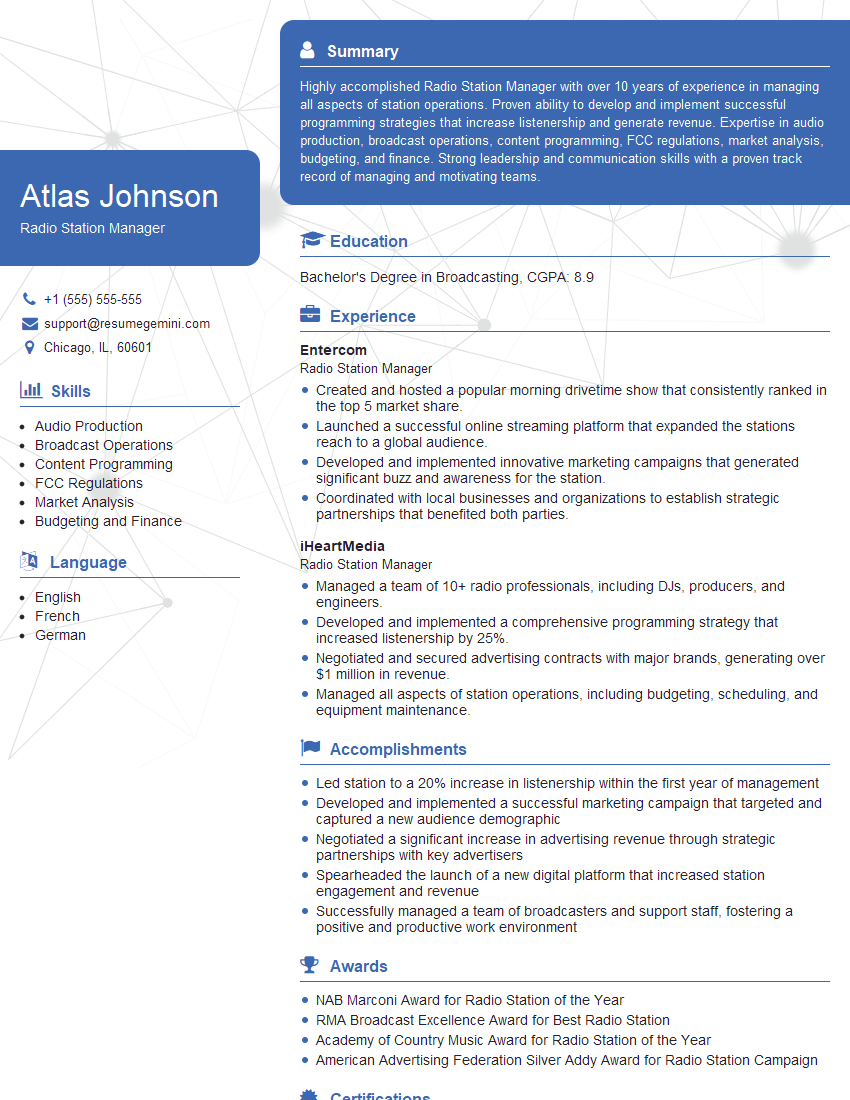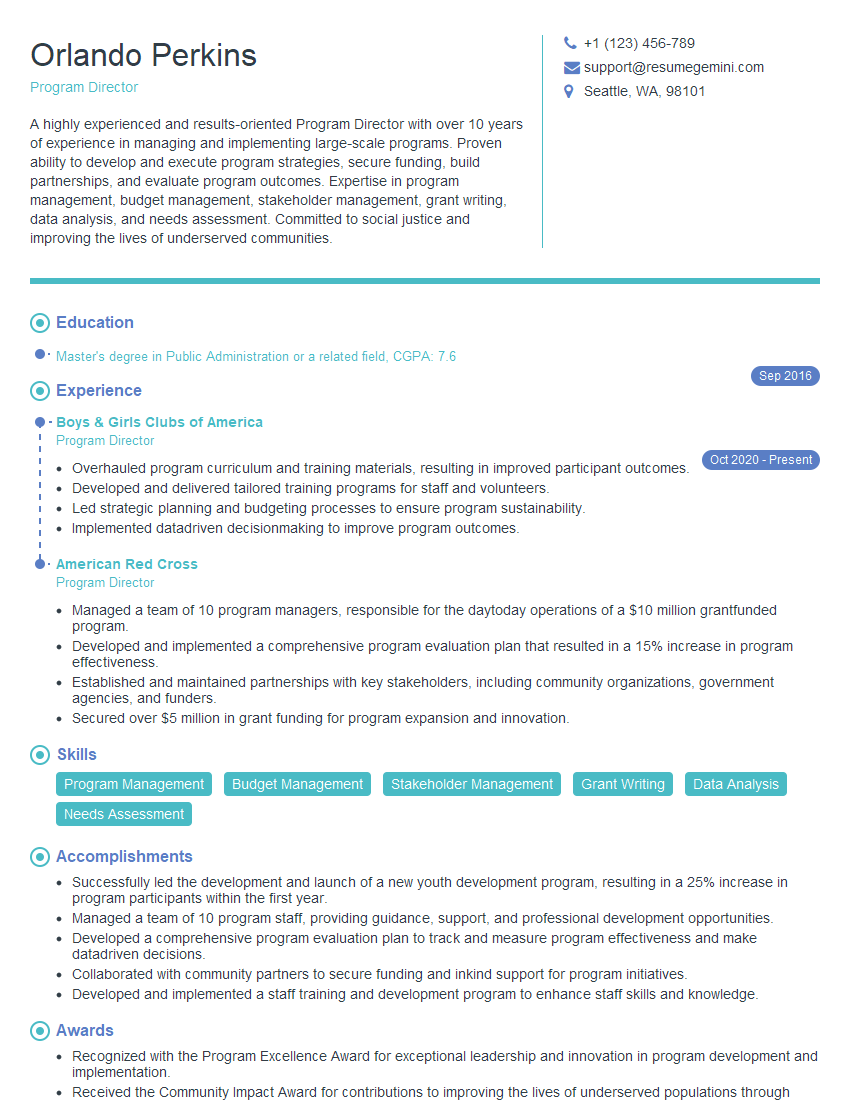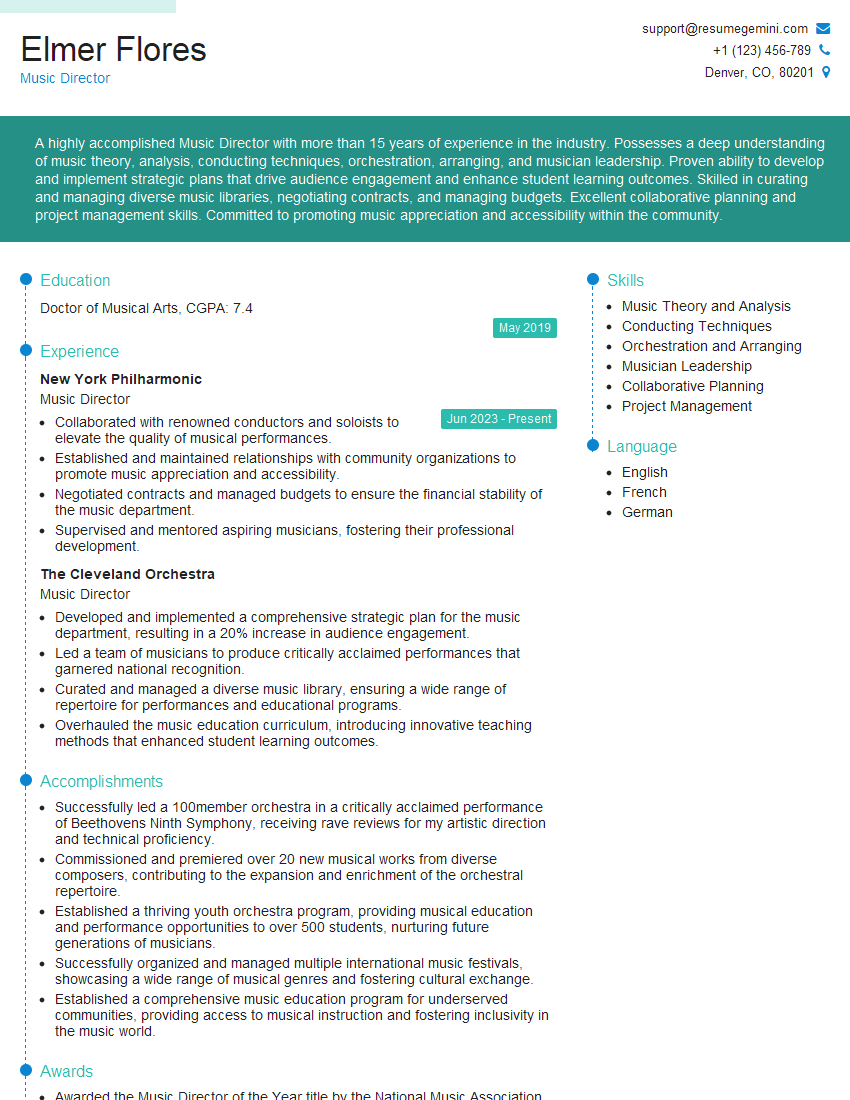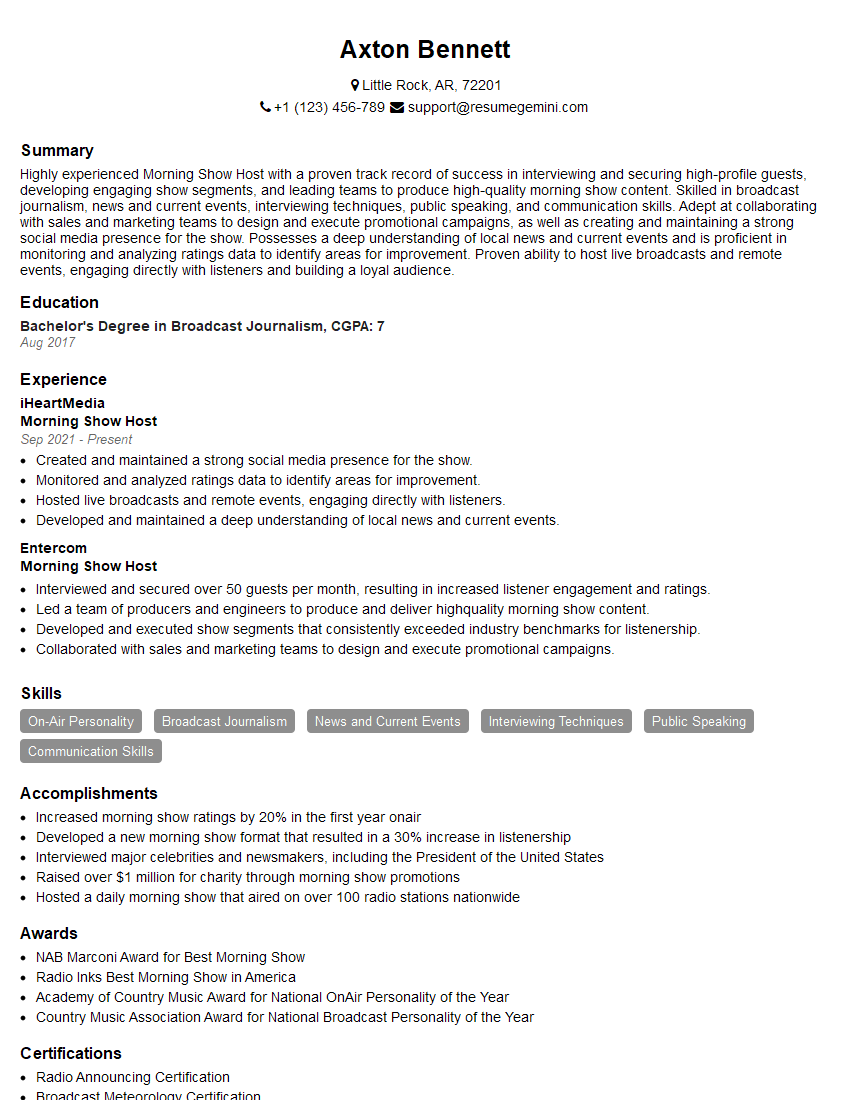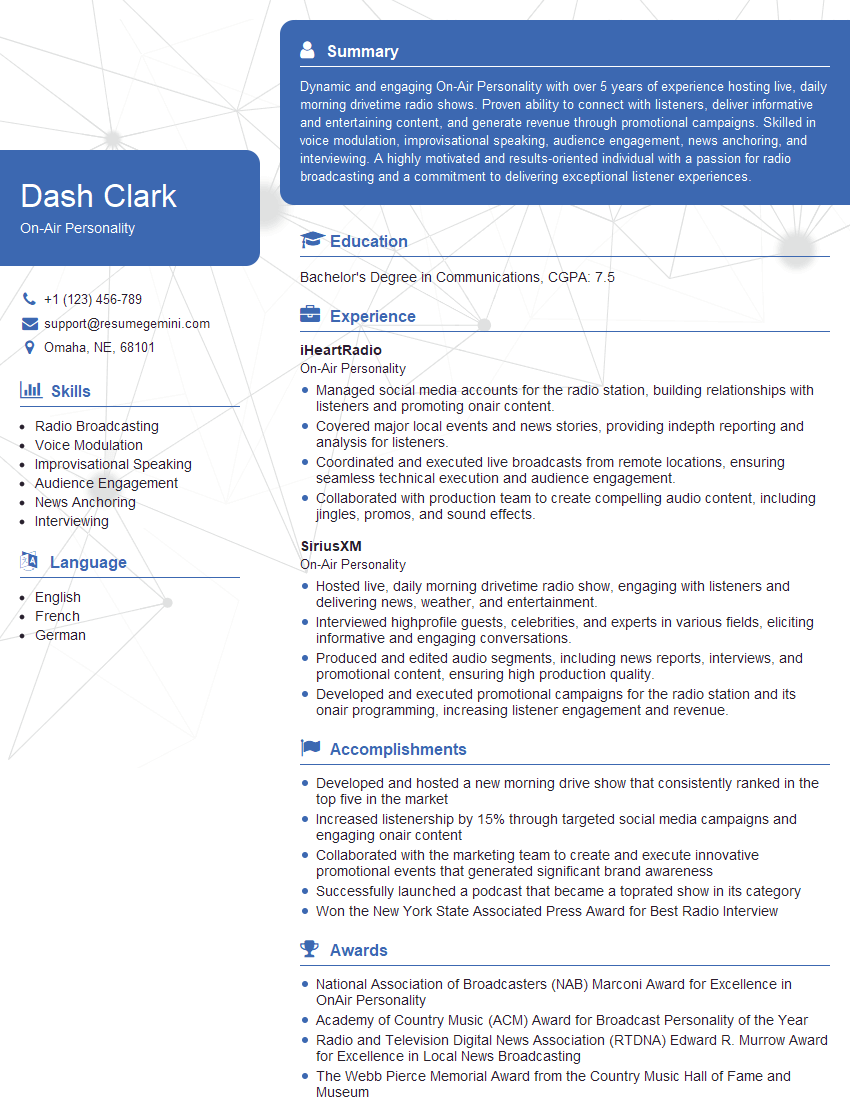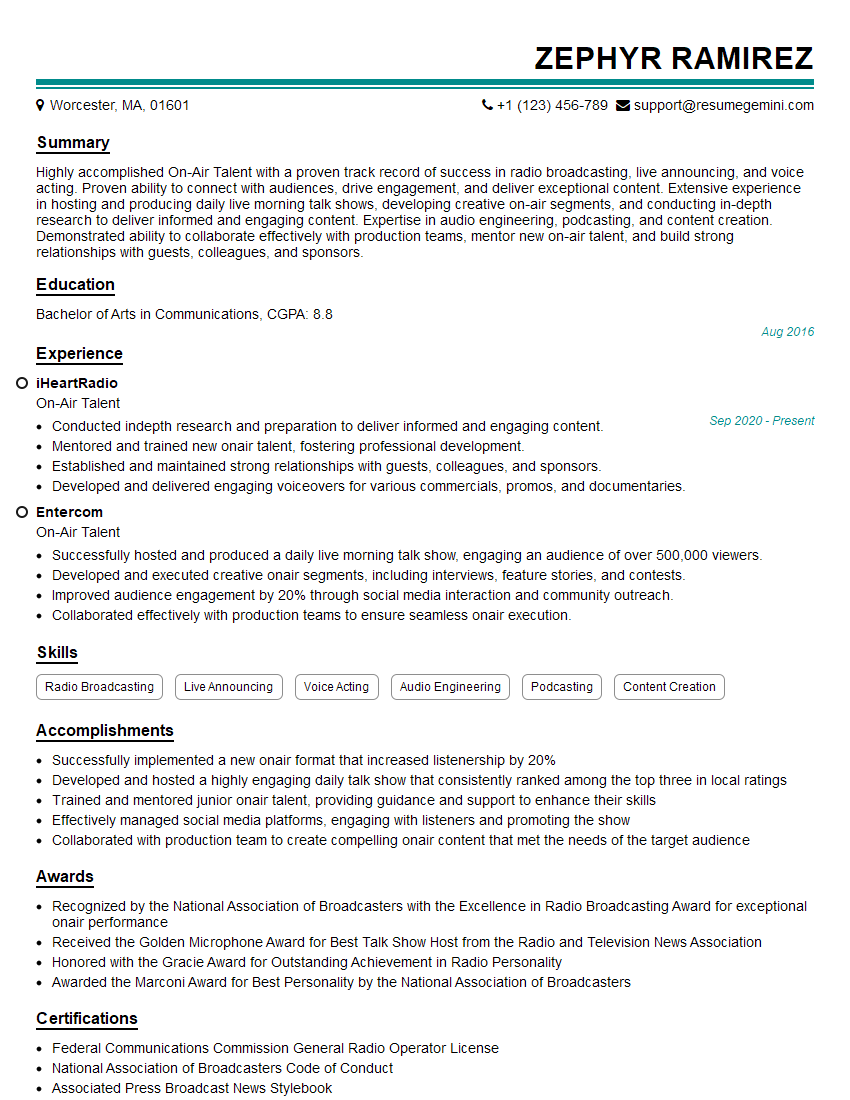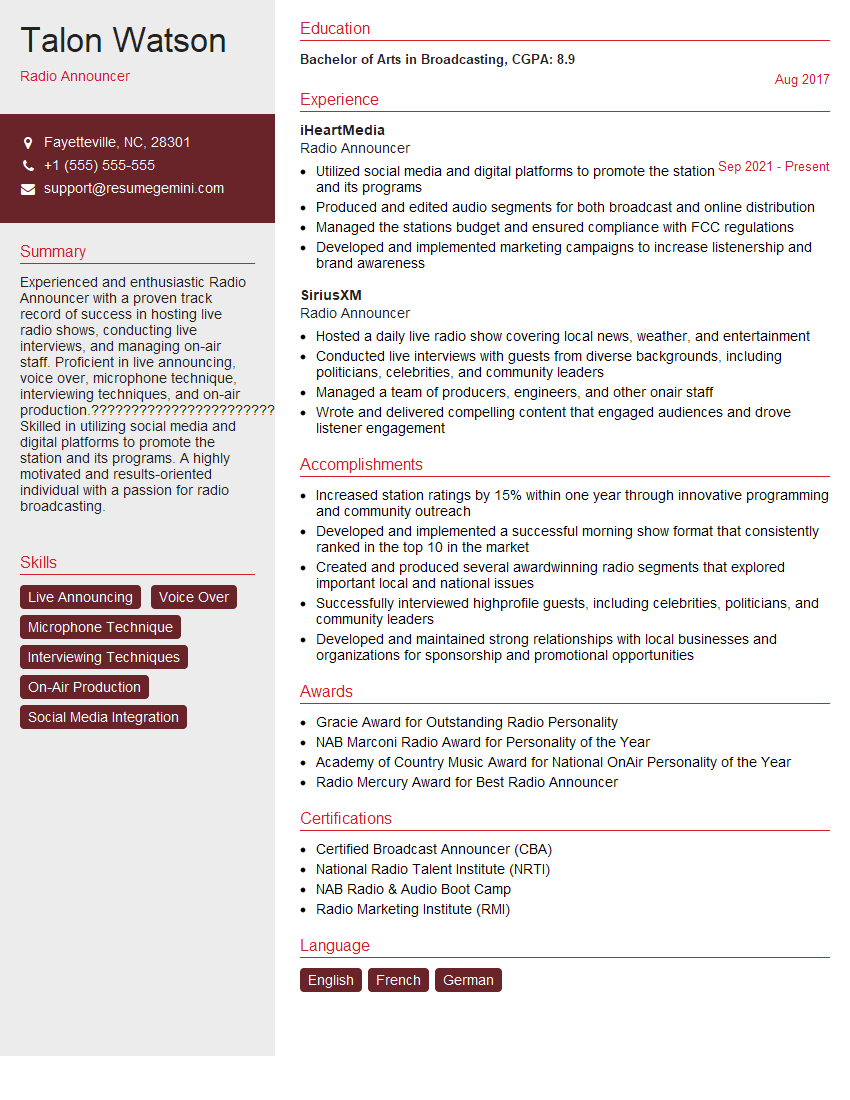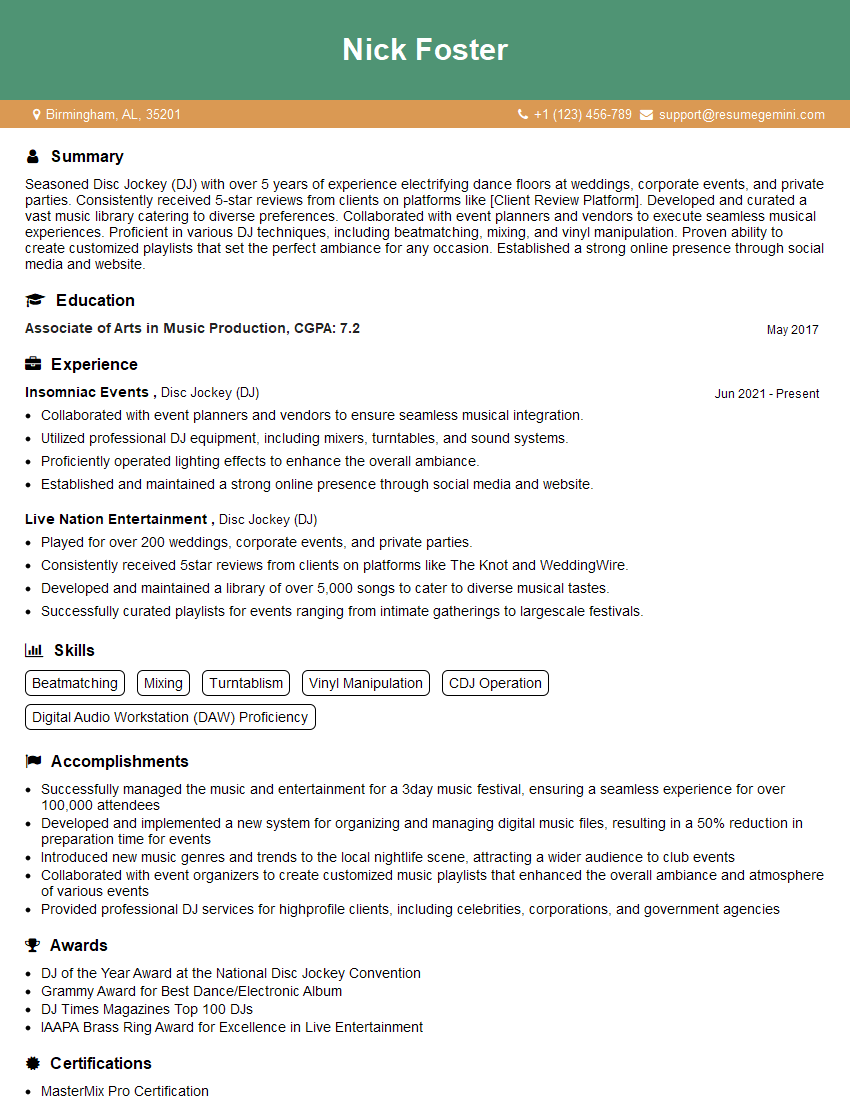Warning: search_filter(): Argument #2 ($wp_query) must be passed by reference, value given in /home/u951807797/domains/techskills.interviewgemini.com/public_html/wp-includes/class-wp-hook.php on line 324
Interviews are opportunities to demonstrate your expertise, and this guide is here to help you shine. Explore the essential Radio DJ interview questions that employers frequently ask, paired with strategies for crafting responses that set you apart from the competition.
Questions Asked in Radio DJ Interview
Q 1. Describe your experience with live broadcasting.
My experience in live broadcasting spans over ten years, encompassing various formats from high-energy morning shows to mellow evening programs. I’ve worked in both small community radio stations and larger commercial networks, gaining valuable experience in different studio environments and technical setups. This has allowed me to adapt quickly to unexpected situations and consistently deliver engaging content. For instance, at my previous station, I hosted a live call-in show where I handled diverse listener calls, ranging from simple requests to complex discussions, all while maintaining the show’s flow and professional tone. I’ve also had experience with live remote broadcasts, requiring meticulous planning and adaptability on location. This diverse experience has honed my skills in quick thinking, improvisation, and seamless execution under pressure.
Q 2. How do you maintain audience engagement during a radio show?
Maintaining audience engagement is crucial for a successful radio show. I achieve this through a multi-pronged approach. Firstly, I create a strong connection with listeners by fostering a sense of community and using conversational language that feels personable and inclusive. Secondly, I actively incorporate listener interaction through call-ins, text messages, social media engagement, and contests. Real-time feedback allows me to tailor the show’s content based on audience preferences. For example, if I see a particular song trend on Twitter, I might incorporate it into the playlist. Thirdly, I meticulously plan engaging segments and features, incorporating varied elements such as news updates, interviews, quirky facts, and humor, to keep things fresh and interesting. Finally, I strive for spontaneity and authenticity; this allows for unplanned moments of connection that resonate deeply with listeners. Think of a time when a surprising event happened – I’d weave it naturally into the show, demonstrating that I’m also a part of the same world they are in.
Q 3. What software or equipment are you proficient with in a radio broadcasting environment?
My proficiency extends across a range of broadcasting software and equipment. I am highly skilled in using audio editing software like Audacity and Adobe Audition for pre-production and post-production tasks. I’m also adept at using broadcast automation systems such as BroadcastCloud and Zetta for playlist management and scheduling. Furthermore, I’m experienced with various studio equipment, including mixing consoles (e.g., Yamaha 01V96i), microphones (Shure SM7B, Neumann U87), and digital audio workstations (DAWs). My expertise encompasses troubleshooting and maintenance of this equipment. For example, I’ve successfully resolved unexpected audio glitches during live broadcasts by swiftly identifying and rectifying the source, preventing on-air disruption. Understanding how different pieces of equipment interact with one another is crucial for smooth broadcast operation.
Q 4. Explain your experience with music selection and programming.
Music selection and programming are integral to crafting a compelling radio show. My experience includes creating playlists tailored to specific demographics and show formats. I understand how to balance musical variety with listener preferences, while adhering to licensing and copyright regulations. I’m proficient in using music scheduling software to create diverse playlists that cater to the target audience and maintain a consistent flow. For instance, I’ve developed thematic playlists around specific genres, eras, or even social trends, which have consistently boosted listener engagement. My approach considers not just the individual songs but also the overall mood and pacing of the playlist to create a cohesive listening experience. This requires a deep understanding of music genres, artists, and listener expectations.
Q 5. How do you handle on-air technical difficulties?
Handling on-air technical difficulties requires quick thinking and a calm demeanor. My approach involves a systematic problem-solving strategy. Firstly, I assess the nature of the problem, focusing on identifying the source of the issue (e.g., microphone failure, software glitch, internet connectivity problem). Secondly, I implement immediate solutions, such as switching to backup equipment or utilizing pre-recorded segments to bridge the gap. Thirdly, I communicate transparently with listeners, reassuring them that the issue is being addressed and keeping them informed about the situation. For example, I might say something like, “We’re experiencing a minor technical issue, but we’ll be back with the music in just a moment.” Finally, I document the incident for future reference, helping prevent similar issues from occurring. The key is maintaining composure and professionalism even under stress.
Q 6. Describe your experience with ad-lib and improvisational broadcasting.
Ad-libbing and improvisational broadcasting are vital for creating a dynamic and engaging radio show. My experience includes smoothly transitioning between segments, responding to unexpected listener calls or on-air events, and incorporating spontaneous humor or observations. This skill requires both extensive preparation and the ability to think on your feet. For instance, I’ve been able to seamlessly weave unexpected news announcements or listener comments into the show’s narrative, demonstrating adaptability and clever improvisation. The ability to connect with the audience in a natural and authentic manner, through unrehearsed moments, is one of the core strengths of radio.
Q 7. How do you manage time effectively during a live radio show?
Effective time management is essential for the success of any live radio show. My approach combines meticulous pre-show planning with flexible on-air execution. I create detailed run sheets with precise timings for each segment, ensuring that the show stays on schedule. However, I also maintain flexibility to adapt to unexpected events or listener interaction. I use visual cues and timers during the show to monitor the time remaining. If a segment runs over, I might seamlessly trim a less essential part or smoothly transition to the next segment. This requires experience, understanding of pacing, and the ability to improvise skillfully. It’s about striking a balance between structure and spontaneity to deliver a show that is both well-organized and engaging.
Q 8. What is your preferred broadcasting style?
My preferred broadcasting style is a blend of informative and entertaining. I aim for a conversational, engaging tone that feels authentic and relatable, rather than overly scripted or formal. I believe in connecting with listeners on a personal level, while still delivering relevant information and a great musical selection. Think of it as chatting with a friend while enjoying fantastic music. I avoid jargon and complex phrasing, preferring clarity and a natural flow. This style allows me to build rapport with my audience and create a loyal following.
For example, if discussing a local event, I wouldn’t simply read a press release. Instead, I would weave in personal anecdotes or opinions, perhaps mentioning how the event relates to my own experiences or the experiences of my listeners. I also incorporate interactive elements, encouraging listener participation through calls, texts, or social media.
Q 9. How do you adapt your presentation style to different target audiences?
Adapting my presentation to different audiences is crucial. I analyze the target demographic – age, interests, cultural background, and even their listening habits – before crafting a show. For instance, a morning drive-time show for commuters demands a more upbeat, energetic style with shorter segments and easily digestible information, focusing on traffic updates and news headlines. In contrast, a late-night show might adopt a more relaxed, introspective tone, focusing on deeper conversations and perhaps a broader range of music.
I achieve this adaptation through several strategies: modifying my vocabulary and pacing, selecting music genres and artists that resonate with the target group, tailoring the content to relevant topics, and choosing appropriate call-to-actions (e.g., encouraging participation through social media or contests).
Q 10. How familiar are you with radio broadcasting regulations and compliance?
I’m very familiar with radio broadcasting regulations and compliance. Understanding and adhering to these rules is paramount. This includes, but isn’t limited to, licensing requirements, broadcast standards, rules around advertising and sponsorship disclosures, and regulations concerning music copyrights and performance rights organizations (like ASCAP, BMI, and SESAC). I’m meticulous about ensuring my programming adheres to all relevant guidelines to avoid legal issues and maintain the station’s reputation.
I regularly review updates to broadcasting regulations and participate in training sessions to remain current. I understand the importance of maintaining accurate and unbiased news reporting and respecting listener privacy. I also have a strong understanding of content that may be offensive or controversial and how to handle such material responsibly.
Q 11. Describe your experience working with a production team.
I have extensive experience collaborating with production teams. This often involves a producer, engineers, and sometimes even marketing or programming staff. Effective teamwork is essential for creating a polished radio show. My role typically involves contributing creative ideas, selecting music, writing scripts or outlines for segments, and delivering the show on-air. The production team handles technical aspects, pre-recording segments, preparing promotional materials, and ensuring smooth transitions.
For example, in a recent show, I collaborated with the producer to develop a theme around local businesses. I interviewed business owners, and the producer handled booking guests, setting up the equipment, and managing the audio levels during the broadcast. This collaborative process leads to a superior product. Clear communication and mutual respect are vital within the team dynamics.
Q 12. How do you handle listener feedback, both positive and negative?
Handling listener feedback is a key aspect of being a successful radio DJ. I actively encourage both positive and negative feedback, viewing it as valuable input for improvement. Positive feedback is naturally rewarding and reinforces what works well. Negative feedback requires careful consideration and a professional response. I address criticisms constructively, showing empathy, and acknowledging listener concerns without becoming defensive.
For instance, if a listener criticizes the music selection, I might research their preference and incorporate it into future playlists or explain the rationale behind my choice. If a listener offers constructive criticism on a segment, I consider how to adjust my approach or content in future programs. Publicly acknowledging and thanking listeners for their feedback, regardless of its nature, fosters a positive and engaging community.
Q 13. How do you research and prepare for a radio show segment?
Research and preparation are crucial for a successful radio show segment. My process typically involves several steps: First, I identify the segment’s theme or topic. Then, I conduct thorough research using a variety of sources like news articles, journals, interviews, and online databases. This ensures accuracy and provides a range of perspectives. I create a detailed outline or script, making sure to break down the information into digestible chunks for the listeners. I also prepare any necessary audio clips or guest interviews.
For example, if preparing a segment on local environmental issues, I’d gather information from local environmental groups, scientific reports, and news coverage. I would then organize the information logically and create an engaging narrative that educates and informs my listeners while keeping the tone light and engaging. Preparation is key to delivering a seamless and informative broadcast.
Q 14. Explain your understanding of radio audience demographics and segmentation.
Understanding radio audience demographics and segmentation is fundamental. Demographics encompass measurable characteristics like age, gender, income, education, and location. Segmentation goes further by grouping audiences based on their shared interests, lifestyles, attitudes, and media consumption habits. Understanding these allows me to tailor my programming effectively to reach specific groups.
For instance, a station targeting a younger demographic (18-24) might focus on pop music, trending topics on social media, and interactive contests, whereas a station aimed at an older demographic (45-65) might focus on classic rock, news updates, and programs on financial planning. I analyze listener data – provided by the station – to get a clear picture of my audience’s demographics and segmentation, using this information to refine programming and maximize engagement.
Q 15. How do you incorporate social media into your radio show?
Social media is an indispensable tool for modern radio DJs. It’s not just about broadcasting; it’s about building a community. I use it in several ways to enhance my show.
- Pre-show promotion: I tease upcoming segments, guests, or special features on platforms like Twitter and Instagram, generating excitement and anticipation.
- Interactive engagement during the broadcast: I encourage listeners to tweet using a dedicated hashtag, allowing real-time interaction and creating a sense of shared experience. I often read out selected tweets on air.
- Post-show follow-up: I share links to podcasts, music playlists from the show, and photos or videos capturing highlights, extending the engagement beyond the airwaves. This helps with building a lasting relationship with my listeners.
- Behind-the-scenes content: Sharing snippets of my workday, studio setups, or even funny bloopers humanizes the experience and allows listeners a glimpse into the ‘making of’ the show.
For example, during a recent interview with a local musician, I used Instagram stories to share quick behind-the-scenes footage and snippets of our conversation, encouraging viewers to tune in. This two-pronged approach – on-air and online – significantly amplified the reach and impact of the interview.
Career Expert Tips:
- Ace those interviews! Prepare effectively by reviewing the Top 50 Most Common Interview Questions on ResumeGemini.
- Navigate your job search with confidence! Explore a wide range of Career Tips on ResumeGemini. Learn about common challenges and recommendations to overcome them.
- Craft the perfect resume! Master the Art of Resume Writing with ResumeGemini’s guide. Showcase your unique qualifications and achievements effectively.
- Don’t miss out on holiday savings! Build your dream resume with ResumeGemini’s ATS optimized templates.
Q 16. How do you use music to enhance the mood and tone of your broadcast?
Music selection is crucial; it’s the backbone of any radio show. I use music strategically to not only entertain but also to set and maintain the mood and tone of my broadcast.
- Setting the atmosphere: Upbeat pop songs at the beginning of the show can create an energetic and welcoming feel. Slower, more mellow tracks can create a more relaxed atmosphere later in the show, perhaps during a segment focused on personal stories.
- Mirroring the content: If I’m discussing a serious news story, I’ll select music with a more somber tone to reflect the gravity of the situation. Conversely, a light-hearted segment might be paired with upbeat and fun music.
- Creating transitions: Music bridges the gap between segments, ensuring a smooth flow and preventing abrupt changes in mood. This helps listeners to stay engaged and feel a sense of continuity.
- Reflecting the target audience: Understanding my listeners’ musical tastes and preferences is vital. I create playlists that cater to their interests, encouraging loyalty and repeat listens.
For instance, if discussing a nostalgic topic, I’ll carefully select songs that resonate with that feeling for my listeners, transporting them back in time and reinforcing the theme of the segment. This creates a strong emotional connection with the broadcast.
Q 17. Describe your experience conducting on-air interviews.
Conducting on-air interviews is a rewarding yet challenging aspect of radio broadcasting. It requires preparation, adaptability, and strong communication skills.
- Pre-interview preparation: Thorough research about the guest and their background is essential. I formulate a list of engaging questions, keeping in mind the show’s format and target audience. I also provide the guest with a brief outline of the topics to be discussed.
- Active listening: During the interview, I listen attentively to the guest’s responses, responding thoughtfully and asking insightful follow-up questions. I’m not just conducting an interview; I’m facilitating a conversation.
- Time management: Staying within the allocated time slot is crucial, particularly when dealing with a live broadcast. I guide the conversation, gently steering the guest back on track if necessary.
- Handling unexpected responses: Sometimes, interviewees might veer off-topic or give unexpected answers. I’ve learned to adapt quickly, turning potentially awkward situations into engaging conversations. My experience and ability to remain calm and professional helps in navigating such situations.
I recently interviewed a renowned author. Initially, they were hesitant to speak about a specific aspect of their work. Through careful questioning and empathy, I built trust, and they eventually shared a fascinating anecdote, leading to a compelling and insightful interview segment.
Q 18. What strategies do you employ to increase listener engagement and retention?
Increasing listener engagement and retention requires a multifaceted approach focusing on providing value, interaction, and consistency.
- Interactive segments: Incorporating listener call-ins, contests, polls, and social media interaction encourages active participation. This creates a sense of community and makes listeners feel valued.
- Exclusive content: Offering podcasts, behind-the-scenes content, or special features accessible only to loyal listeners creates a sense of exclusivity and reward.
- Consistent high-quality content: Maintaining a consistent broadcast schedule and delivering high-quality segments keeps listeners coming back for more. It establishes a routine and a sense of dependability.
- Understanding the target audience: Thorough knowledge of the listeners’ demographics, preferences, and interests is critical in creating relevant and engaging content. This allows me to craft shows and segments that resonates with them.
- Feedback mechanism: Regularly soliciting feedback from listeners helps identify what’s working and what could be improved. This iterative approach ensures the show remains relevant and engaging.
For example, a recurring segment where I answer listeners’ questions about a particular topic not only increases interaction but also fosters a sense of direct communication and builds trust between me and my audience.
Q 19. How do you handle unexpected events or news during a live broadcast?
Handling unexpected events or news during a live broadcast requires quick thinking, adaptability, and a calm demeanor. My approach involves:
- Staying informed: I constantly monitor news sources during the broadcast. Having a reliable news feed readily accessible is vital.
- Adapting the show: Depending on the urgency and relevance, I might briefly interrupt the planned segments to deliver important news updates, or I might seamlessly incorporate the news into the existing flow of the show.
- Maintaining professionalism: Even amidst unexpected events, maintaining a professional and calm demeanor is crucial. Panicking or showing discomfort will transmit negatively to the listeners.
- Using available resources: If the news requires further explanation, I might consult with a newsroom or relevant experts to ensure the accuracy and context of the information.
- Offering reassurance and context: Providing context and reassurance to listeners during times of uncertainty helps to calm anxieties and builds trust.
During a recent broadcast, a major weather alert was issued. I immediately interrupted the current segment, delivering the alert clearly and calmly, providing listeners with actionable advice and directing them to relevant resources. I then seamlessly transitioned back to the show’s previously planned content. This demonstrates a professional approach to live broadcasting, maintaining an important balance between news and entertainment.
Q 20. What are your strengths and weaknesses as a radio broadcaster?
Like any profession, radio broadcasting involves strengths and weaknesses.
- Strengths: My strengths lie in my engaging on-air personality, ability to connect with listeners, and my comprehensive understanding of music and current events. I’m adept at improvising and maintaining a smooth flow, even during unexpected circumstances. I am also known for my careful preparation and excellent time management skills.
- Weaknesses: My ability to quickly adapt to technical difficulties could be improved. While I can handle most situations well, unexpected technical problems can sometimes create minor disruptions. Also, learning to delegate certain tasks more effectively to my production team could enhance overall efficiency.
I actively work to overcome my weaknesses. I regularly participate in technical workshops to improve my problem-solving skills, and actively involve my production team in the planning and execution phases of the show. This collaborative approach not only improves efficiency but also encourages better team dynamics.
Q 21. How do you stay updated on current events and trends relevant to your broadcast?
Staying updated on current events and trends is paramount for a radio DJ. My strategy is multi-faceted:
- News aggregators and reputable news sources: I rely on trusted news organizations and aggregators to stay abreast of breaking news and current affairs. This ensures the information I share is accurate and credible.
- Social media monitoring: Social media platforms provide real-time insights into trending topics and public sentiment. This helps me identify relevant discussions and tailor content accordingly.
- Industry publications and podcasts: Following industry publications and podcasts keeps me informed about the latest trends and innovations in radio broadcasting and media. It helps me stay ahead of the curve.
- Engagement with the community: Interacting with listeners through call-ins, social media, and email provides valuable feedback and insights into their interests and concerns. This informs my content choices and ensures the relevance of the show.
For example, I regularly listen to industry podcasts that discuss the latest in radio programming and marketing. This allows me to adopt the best practices and remain competitive in the dynamic landscape of radio broadcasting.
Q 22. How do you build rapport with listeners?
Building rapport with listeners is the cornerstone of successful radio DJing. It’s about creating a genuine connection that makes listeners feel heard, understood, and valued. This isn’t about being a performer; it’s about being a conversationalist.
Authenticity: Being yourself is paramount. Listeners can spot fakery a mile away. Let your personality shine through, share relatable anecdotes, and be vulnerable when appropriate.
Active Listening (Even Though You’re Talking!): When you take calls or read listener messages, truly listen to what they’re saying. Respond thoughtfully, even if it’s just acknowledging their feelings.
Engagement: Run contests, polls, and Q&A sessions. Encourage interaction through social media, email, or text messages. Make listeners feel like they’re part of a community.
Consistency: Develop a consistent on-air persona and style. This creates predictability and familiarity, allowing listeners to tune in knowing what to expect.
For example, I once had a listener call in about a frustrating experience at the DMV. Instead of simply moving on to the next song, I empathized with their situation, shared a similar funny anecdote, and even offered practical advice. This simple act of connection solidified that listener’s loyalty.
Q 23. What is your experience with different audio formats (MP3, WAV, etc.)?
My experience with various audio formats is extensive. While MP3 is the industry standard for broadcast due to its smaller file size and ease of transmission, understanding the nuances of each format is crucial for maintaining audio quality.
MP3: Lossy compression – great for broadcasting due to its small size, but some audio information is lost, impacting the overall sound quality. The bitrate (e.g., 128kbps, 320kbps) significantly impacts quality; higher bitrate means better quality but larger file size.
WAV: Lossless compression – excellent quality, preserving all the original audio data. However, significantly larger file sizes make it less suitable for broadcast unless streaming services or online archiving is involved.
AIFF (Audio Interchange File Format): Another lossless format, often used in professional audio editing and mastering. Similar to WAV in quality but with different metadata handling.
AAC (Advanced Audio Coding): A lossy format like MP3 but generally considered to offer better quality at similar file sizes. Increasingly popular for online streaming.
I am adept at choosing the appropriate format for different situations. For broadcast, I prioritize MP3 at a high enough bitrate to maintain sound quality. For archiving or studio work, lossless formats like WAV or AIFF are preferred.
Q 24. Describe your familiarity with audio editing software.
I’m proficient in several audio editing software packages, including Audacity (for basic editing and quick fixes), Adobe Audition (for more advanced tasks like mastering and noise reduction), and Pro Tools (for professional level audio production and mixing).
Audacity: Excellent for simple edits such as trimming audio clips, removing unwanted sections, and applying basic effects.
Adobe Audition: Offers a wide array of tools including noise reduction, equalization (EQ), compression, and advanced audio restoration. Ideal for preparing high-quality audio for broadcast.
Pro Tools: Industry-standard DAW (Digital Audio Workstation) for recording, editing, mixing, and mastering. Used for more complex projects involving multiple tracks and instruments.
My skills extend to tasks such as removing background noise, correcting audio levels, creating jingles and sound effects, and preparing segments for seamless broadcasting. I can quickly troubleshoot technical issues and adapt to different software interfaces.
Q 25. How do you manage your workload and prioritize tasks in a fast-paced environment?
Working in radio requires exceptional time management and prioritization. My approach is a blend of planning and flexibility. I use a combination of digital and traditional methods to stay organized.
Planning: I create detailed weekly schedules, outlining show segments, music selections, and planned promotional content. This ensures a smooth workflow.
Prioritization: I use a system that categorizes tasks by urgency and importance (using a matrix or similar system). Critical tasks like show preparation always take precedence.
Flexibility: In a live environment, unexpected things happen. I’m adept at adapting to changes in the schedule, responding to breaking news or technical glitches while maintaining composure and show quality.
Technology: I utilize task management tools like Trello or Asana to track progress and deadlines. Digital calendars are essential for scheduling.
For example, during a period of staff shortages, I quickly adjusted my workflow to cover extra shifts while maintaining high-quality content, by pre-recording certain segments and efficiently utilizing automation tools.
Q 26. Describe a time you made a mistake on-air. How did you handle it?
During a live broadcast, I accidentally played an inappropriate song – a song with explicit lyrics that was not suitable for the time slot. This was due to a mix-up in my playlist.
Immediately, I apologized on-air, acknowledging my mistake and explaining that it was an unintentional error. I then quickly transitioned to a more appropriate song and tried to address the situation with humor and grace to alleviate listener concerns. Afterwards, I reviewed my playlist and processes to ensure it wouldn’t happen again. I also learned to double-check my queue before going live.
The key takeaway was not to let the error define the show. A quick, sincere apology and a professional recovery were crucial in maintaining listener trust and the integrity of the station’s image. Transparency is key in these situations.
Q 27. What are your salary expectations for this role?
My salary expectations for this role are in the range of [Insert Salary Range] annually. This is based on my experience, skills, and the responsibilities of this position within the current market rate for similar roles in this area. I am open to discussion and willing to negotiate based on a comprehensive benefits package.
Q 28. Why are you interested in this specific radio station/position?
I’m particularly drawn to [Station Name] because of its [mention specific aspects like commitment to local community, unique programming style, strong reputation, etc.]. I admire [Station’s specific achievement or programming decision]. My passion for [mention specific genre or type of programming] aligns perfectly with the station’s focus. I believe my skills and experience would be a valuable asset to your team, and I’m excited about the opportunity to contribute to the station’s continued success.
Key Topics to Learn for Radio DJ Interview
- Understanding Your Audience: Analyze different demographics and tailor your presentation style accordingly. Consider how to connect with listeners of varying ages and backgrounds.
- Music Selection & Programming: Discuss your knowledge of various music genres, current chart trends, and the art of creating engaging playlists. Explain how you would build a cohesive and exciting radio show.
- On-Air Presentation & Delivery: Practice your vocal skills, pacing, and enunciation. Explain your approach to improvisation and handling unexpected situations, like technical difficulties or guest cancellations.
- Technical Proficiency: Demonstrate understanding of radio broadcasting equipment, software, and audio editing techniques. Be prepared to discuss your experience with studio technology and your ability to troubleshoot issues.
- Show Preparation & Planning: Explain your process for researching topics, preparing scripts, and structuring your show to maximize listener engagement. Highlight your organizational skills and ability to manage time effectively.
- Interviewing Skills: Showcase your ability to conduct engaging and informative interviews with guests. Explain your techniques for building rapport, asking insightful questions, and managing interview flow.
- Legal & Ethical Considerations: Demonstrate awareness of broadcasting regulations, copyright laws, and responsible on-air conduct. Show understanding of the importance of maintaining professionalism and ethical standards.
- Marketing & Promotion: Discuss how you would promote your show and connect with listeners beyond the airwaves. This could involve using social media, online platforms, or community outreach.
Next Steps
Mastering the art of radio DJing opens doors to exciting career opportunities in broadcasting, entertainment, and media. A strong resume is crucial for showcasing your skills and experience to potential employers. Creating an ATS-friendly resume significantly increases your chances of getting noticed. To build a professional and effective resume that highlights your unique talents and experience, we highly recommend using ResumeGemini. ResumeGemini provides you with the tools and resources to craft a compelling resume, and we offer examples of resumes tailored specifically to Radio DJ positions to help you get started.
Explore more articles
Users Rating of Our Blogs
Share Your Experience
We value your feedback! Please rate our content and share your thoughts (optional).
What Readers Say About Our Blog
Hi, I represent a social media marketing agency that creates 15 engaging posts per month for businesses like yours. Our clients typically see a 40-60% increase in followers and engagement for just $199/month. Would you be interested?”
Hi, I represent an SEO company that specialises in getting you AI citations and higher rankings on Google. I’d like to offer you a 100% free SEO audit for your website. Would you be interested?
